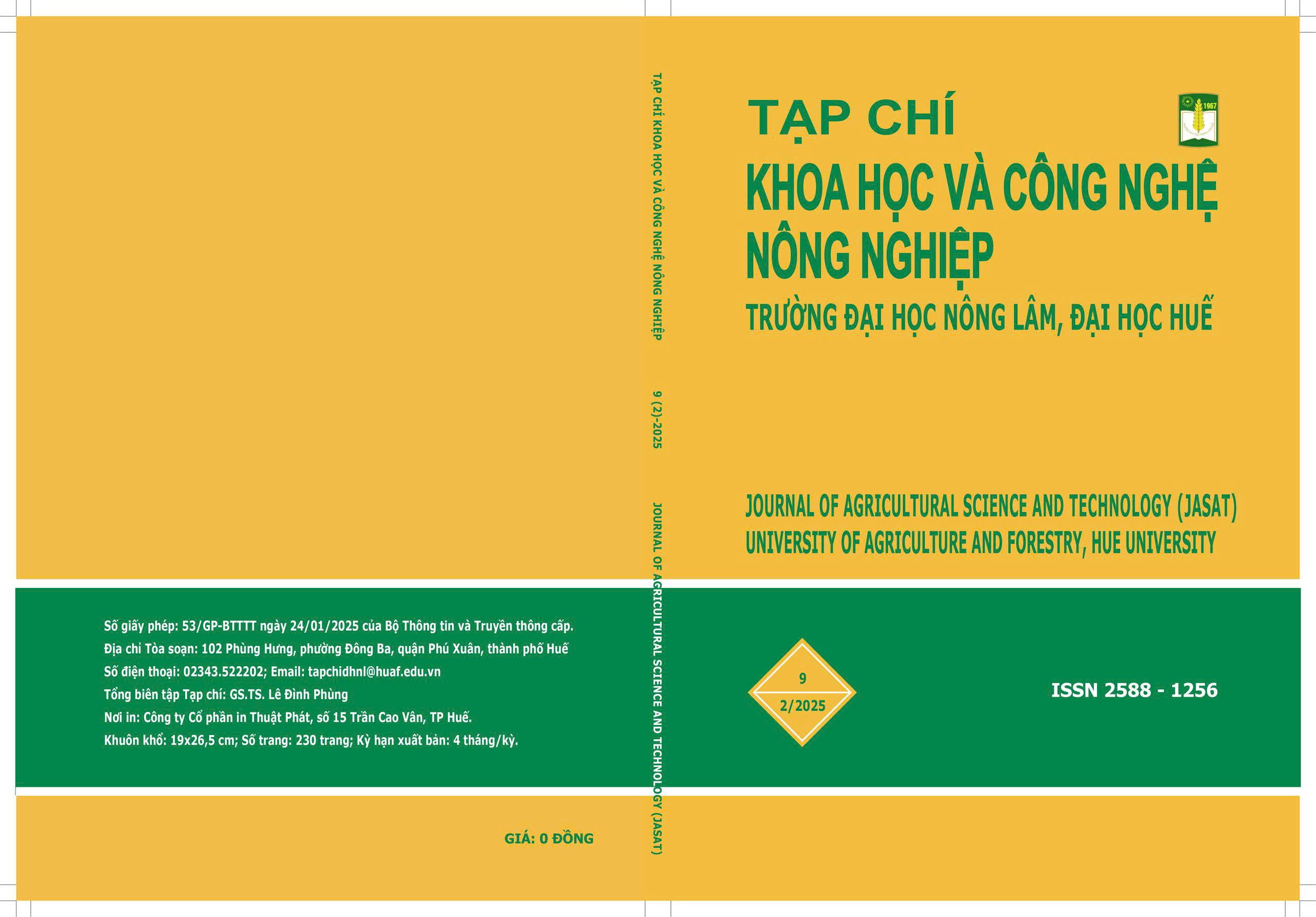##plugins.themes.huaf_theme.article.main##
Tóm tắt
Nghiên cứu được thực hiện nhằm đánh giá ảnh hưởng của thời gian luộc (0, 50, 70, 90 và 110 phút) ở nhiệt độ 95 - 100°C và nồng độ muối ăn (natri clorua) bổ sung trong dịch rót (4,0; 4,5; 5,0 và 5,5%) đến chất lượng của sản phẩm măng vót dầm tỏi ớt. Các chỉ tiêu phân tích bao gồm cảm quan như màu sắc, mùi, vị, trạng thái và một số chỉ tiêu chất lượng quan trọng như hàm lượng chất khô hòa tan, hàm lượng HCN, độ cứng, hàm lượng polyphenol tổng số. Kết quả chỉ ra rằng điều kiện thích hợp cho quá trình chế măng dầm tỏi ớt là thời gian luộc 90 phút và nồng độ muối bổ sung vào dịch rót 4,5%. Ở điều kiện này, sản phẩm măng vót dầm tỏi ớt đạt các chỉ tiêu chất lượng với hàm lượng vitamin C là 11,2 mg/kg, hàm lượng đường khử là 5,84%, pH là 4,24, đồng thời sản phẩm đáp ứng tiêu chuẩn vệ sinh an toàn thực phẩm theo TCVN 13119:2020 về sản phẩm măng đóng hộp.
##plugins.themes.huaf_theme.article.details##
Tài liệu tham khảo
Chu Doãn Thành. (2006). Nghiên cứu hoàn thiện công nghệ bảo quản và chế biến chuối, măng. Bộ Nông nghiệp và Phát triển nông thôn, Viện nghiên cứu rau quả Hà Nội
Nguyễn Văn Toản. (2012). Xây dựng mô hình ứng dụng các giải pháp kỹ thuật nhằm nâng cao chất lượng chế biến, tiêu thụ sản phẩm măng Gia Lai. Báo cáo tổng kết đề tài cấp Tỉnh.
Hà Duyên Tư. (2010). Kỹ thuật phân tích cảm quan thực phẩm. Nhà xuất bản Khoa học và Kỹ thuật Hà Nội.
Barker, L. (2002). Postharvest technical training handbook, Industries Queensland Department of Primary Industries, Australia.
Bhardwaj, D. R., Rana, S., Kumar, D., & Sharma, P. (2023). Nutritive value of tender shoots of different bamboo species in relation to harvesting height in mid-hills of north-western Himalayas, Applied Food Research, 3(1). DOI: 10.1016/j.afres.2023.100279.
Choudhury, D., Sahu, J.K., & Sharma, G. D. (2010). Biochemistry of bitterness in bamboo shoots. Assam University Journal of Science & Technology, Physical Sciences and Technology, 6(2), 105-111.
Ferreira, V. L. P., Yotsuyanagi, K., & Carvalho, C. R. L. (1995). Elimination of cyanogenic compounds from bamboo shoots Dendrocalamus giganteus Munro. Tropical Science, 35(4), 342-346.
Gunathilake, K. D. P. P., Ranaweera, K. K. D. S., & Rupasinghe, H. P. V. (2018). Effect of different cooking methods on polyphenols, carotenoids and antioxidant activities of selected edible leaves. Antioxidants (Basel), 7(9), 117.
Irina, I., & Mohamed, G. (2012). Biological activities and effects of food processing on flavonoids as phenolic antioxidants. Advances in Applied Biotechnology, 101-124.
Jaiwunglok, P., Tia, S., & Yoovidhya, T. (2010). Effectes of temperature and pH on taxiphyllin degradation in bamboo shoots. Food Innovation Asia Conference, Indigenous Food Research and Development to Global Market, BITEC Bangkok, Thailand, 17-18.
Priya, P., Priyanka, T., Sahoo, A., Awasthi, P., & Pandey, A. (2018), Reducing hydrocyanic acid content, nutritional and sensory quality evaluation of edible bamboo shoot based food products. International Journal of Chemical Studies, 6(4), 1079-1084.
Rana, B., Awasthi, P., & Kumbhar, B. K. (2012). Optimization of processing conditions for cyanide content reduction in fresh bamboo shoot during NaCl treatment by response surface methodology. Food Science and Technology, 49, 103-109.
Rawat, K., Nirmalaand, C., & Bisht, M. S. (2015). Processing techniques for reduction of cyanogenic glycosides from bamboo shoots. 10th World Bamboo Congress, Korea, 1-12.
Singleton, V. L., Orthofer, R., & Lamuela-Raventós, R. M. (1999). Analysis of total phenols and other oxidation substrates and antioxidants by means of folin-ciocalteu reagent, methods in enzymology. Elsevier, 299, 152-178.
Tang, J., Wu, X., Lv, D., Huang, S., Zhang, Y., & Kong, F. (2024). Effect of salt concentration on the quality and microbial community during pickled peppers fermentation. Food Chemistry: X, 23. DOI: 10.1016/j.fochx.2024.101594.
Thounaojam, P., Bisht, M. S., & Nirmala, C. (2017). Effect of processing on nutritional and phytochemical contents in shoots of an edible bamboo Dendrocalamus latiflorus Munro. International Journal on Agricultural Sciences, 8,79–87.
Zhang, S., Li, C., Wu, J., Peng, S., Mao, H., Wu, W., & Liao, L. (2023), Effect of salt concentration on flavor characteristics and physicochemical quality of pickled Brassica napus. Fermentation, 9(3), 275.


